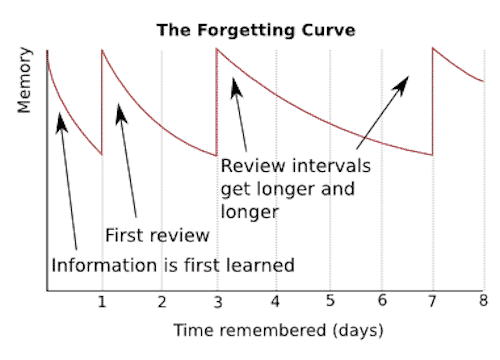All Mandarin learners know the hardest part about the language is the need to memorize thousands of unique Chinese characters to achieve elementary level literacy. Spaced repetition has long been a popular strategy for utilized by students learning Chinese to review new vocabulary. Recently, one of the leading Chinese learning blogs Hacking Chinese wrote an excellent article comparing reading and spaced repetition software to determine which one is more efficient for learning Chinese. This article aims to expand upon this issue in the context of teaching children the Chinese language.
What is spaced repetition?
In order to retain information, our brain must revisit it every now and then. (For readers who prefer a computer analogy, think “cache.”) For information that you regularly access (such as recipe that you frequently cook), it’s easy to recall but once you stop using that information, the information fades.

Spaced repetition is often built into flashcard software to help learners review information at gradually increasing time intervals. This mechanism helps learners learn efficiently by allocating more time (and brain power) to the newly acquired information and less time (and brain power) to the information already learned/reviewed. Smarter algorithms may even customize the optimal repetition interval for each learner based on past performance. The following diagram showing the Forgetting Curve further demonstrates how spaced repetition works to help combat our brain’s tendency to forget.
Reading is spaced repetition++
As Kevin over at Hacking Chinese so elegantly laid out, reading is actually a form of spaced repetition as the “spacing between occurrences of a word is an incidental result of what is written.” His studies also
Reading is also an efficient way to learn Chinese because by learning 500 of the most frequently used characters, one will recognize 75% of the characters on an average page of modern Chinese text. Learning 1,000 characters means recognition of 90% of the characters and learning 2000 gives one over 97% recognition. (Keep in mind though that a Chinese character is not equivalent to a Chinese word. While a character can also be a word, most words are a combination of characters so simply counting # characters can be rather misleading as to a learner’s true level.)
Reading, however, is not just spaced repetition. It is spaced repetition with these extra benefits:
- Reading allows learning and application to take place simultaneously.
- It introduces the characters/words in a variety of contexts.
- It teaches sentence structures and expressions.
- A good story line can intrigue the learner and curiosity is an effective driver for learning.
- Good writing incorporates culture – expressions, values, traditions, legends, etc.
- If the text is well written, it is an enjoyable event instead of a daunting task. (Think Harry Potter… I can’t tell you how many nights I hid 金庸 books under my comforter so I can read after my parents go to bed.)
- Reading gives a learner purpose (and sense of accomplishment) for learning the language.
- It promotes self-learning.
While the above features can benefit all learners, they are especially important to children as they do not learn a language the way adults learn. Neurologists have long concluded that children use their “deep motor area” to learn a second language through processes that are not consciously thought about. Furthermore, every teacher knows that if a child is bored, the child will not learn. Hence, reading is usually the better way of teaching children new information than flashcards alone.
However, not all Chinese authentic text is written with spaced repetition in mind. In fact, most aren’t. Most Chinese children’s books focus on sentence length (and to some extent structure) rather than the placement of characters. That is understandable as most authors are focused more on storytelling and character development than on teaching vocabulary. Furthermore, written Chinese is often much more advanced through to its formality when compared to spoken Chinese.
What if we read stories written using the spaced repetition method?
That’s what we set out to do with Little Chinese Readers — to write leveled engaging stories grounded in the spaced repetition method. Each level contain 10-12 lessons and students learn an average of 4~6 characters per lesson through a spaced-out storyline. The following pictures show how the Level 3 lesson on the topic of “length” progresses this way (with new vocabulary highlighted in blue). Students can toggle on pinyin/zhuyin/English or just tap the character to hear its sound. (Our storyline and illustration are also meticulously designed to engage children’s deduction and inference reasoning — how? Let’s save that topic for another day.)
After learning ~50 characters, learners independently read the level stories written using only the characters already encountered. The result is a series of leveled readers turbo charged with the effect of spaced repetition and a highly efficient and effective way of helping children (and adults who think/act like children) learn Mandarin. The following chart shows how characters are introduced and repeated over each lesson, story, and level.

Does this mean flashcards are bad for kids?
Of course not! We incorporate some flashcards into our guided lessons as well because every child is different and because every teaching tool has its place if used effectively. Combining flash cards and games is a great way to learn. Kids will pick up new vocabulary that way before you finish saying supercalifragilisticexpialidocious. On the other hand, reading Harry Potter n a monotone voice has a risk of putting the most studious children to sleep. The #1 motto at Little Chinese Readers is to keep the learning fun! Try our first three lessons for free today.






